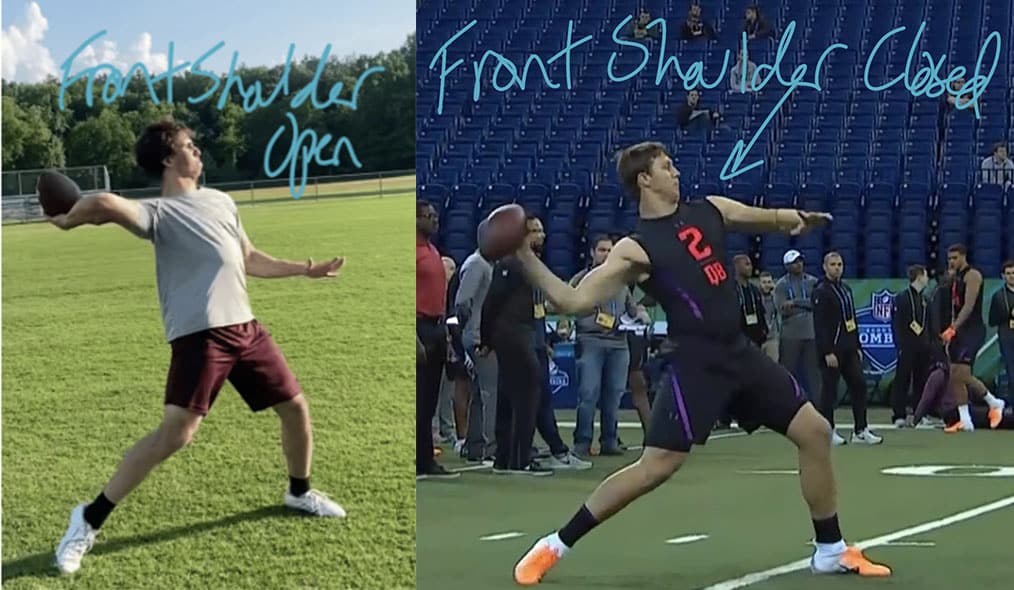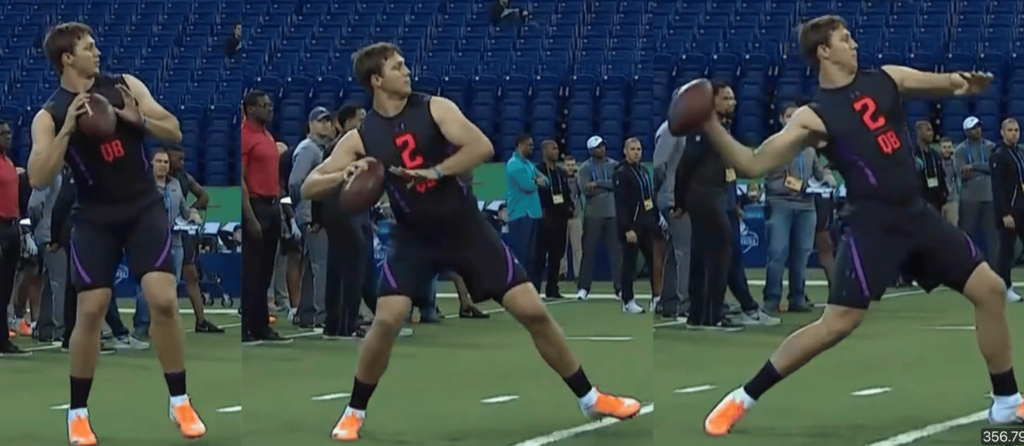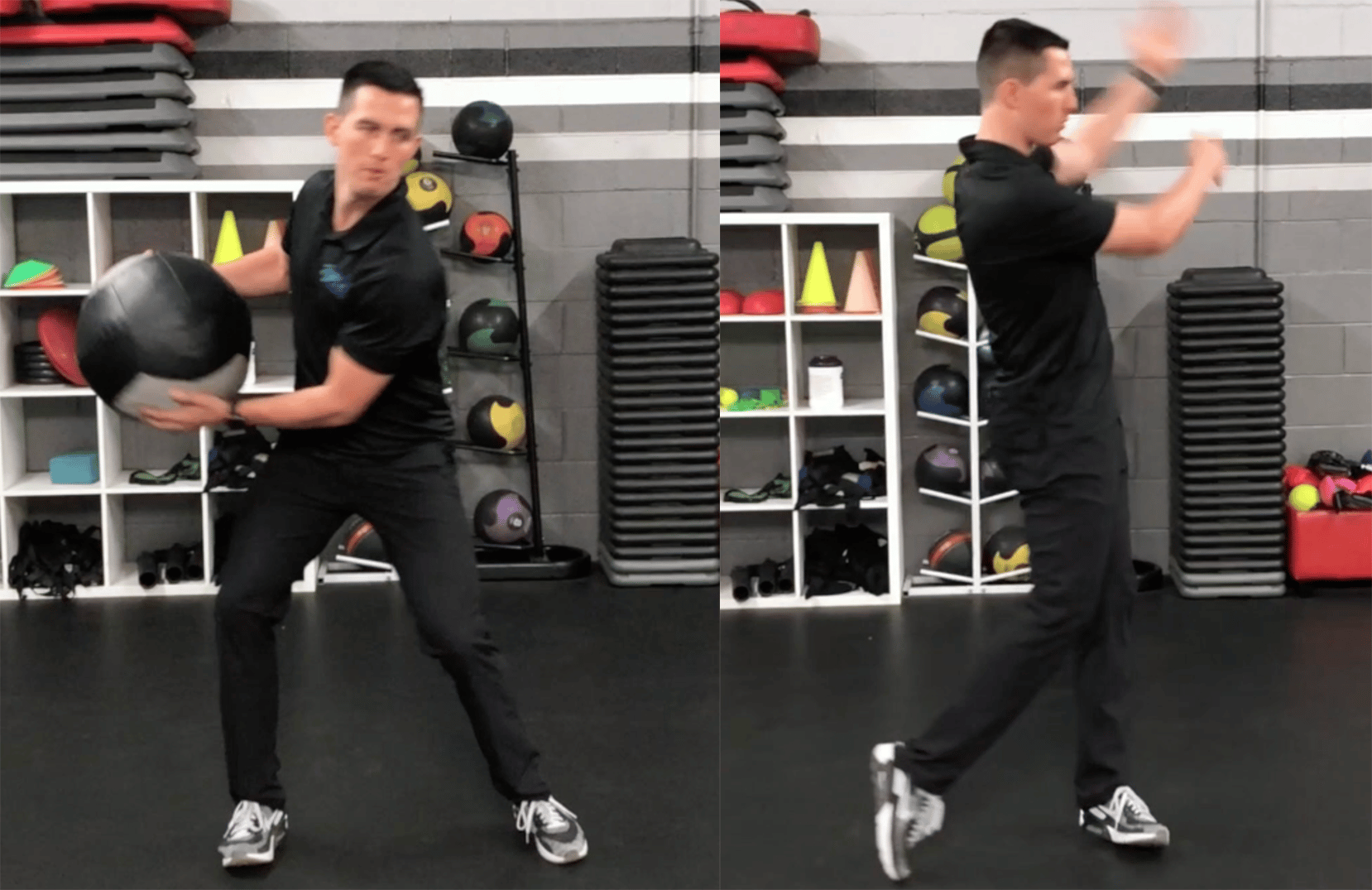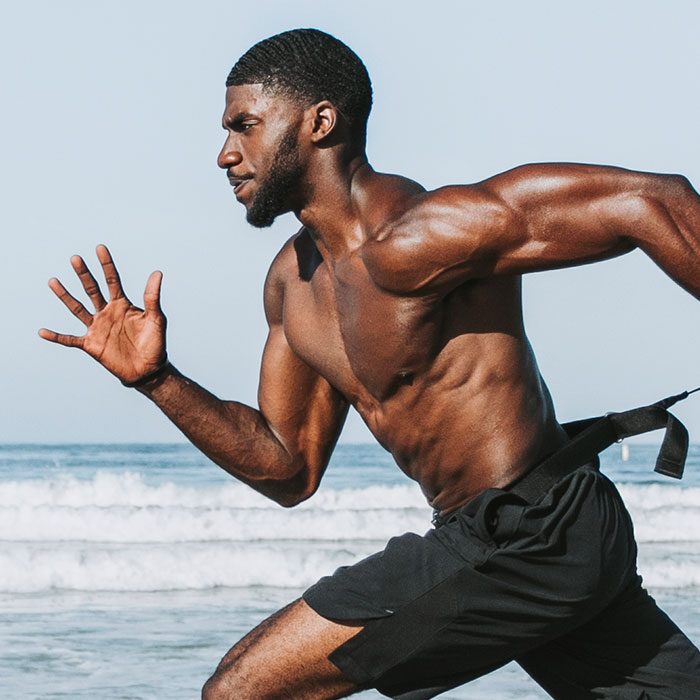How To Throw A Football Farther

The 4 Keys To Improving Arm Strength
- Maximizing the efficiency and body mechanics from your foot position through to your throwing arm to throw the football as a far as possible.
- Have and follow a specific strength program to improve overall strength of the shoulder, core, hips, grip, etc.
- Have a warm up and cool down routine to improve your range of motion in the shoulder, elbow, wrist and spine to your arm healthy.
- Have a structured throwing regimen to test max distance and velocity, as well as strategize what are the most important parts of the throwing motion that needs to improve.
The Goal Of This Page Is To Show You Everything You Need To Know to Throw The Ball 10-15 Yards Further In A Few Weeks
In order to throw the football further there are a few critical components that need to be achieved in order to improve overall power. The most common mistake I have seen in analyzing thousands of hours of quarterbacks throwing is not having a proper base. When a quarterback is preparing to throw a football farther, there load and arm path change because of the throwing trajectory. However, many times the base or front foot contact lengthens which causes the weight to shift forward to early. This causes a decrease in power in the throwing arm, and leads to overuse injuries as well as poor performance.
The Most Important Parts To Throw A Football Farther
1. The Arm Path

The most important thing to consider to throw a football farther is the arm path. Most quarterbacks screw up the arm path in one way or another when throwing the football farther because throwing motion changes when throwing the football far vs underneath. There are two main changes that happen when throwing the football farther 1. release point changes 2. The lead foot takes a bigger step. Therefore, the release position is further back while taking a bigger step gets the weight to shift forward sooner.
2. The Wrist
Additionally, after loading the football the elbow wants to come through/forward with limited action happening in the wrist other than turning toward the target. If the wrist bends too much or the elbow doesn’t come through immediately the ball will end up too far behind the head or towards the midline. This limits the amount of centrifugal force that can be created from the wrist and hand.

Neutral Position
Lastly, when the ball is actually coming out of the hands the wrist wants to be in a neautral position when throwing underneath but the ball should be pointing upwards when throwing the football farther. The more the knuckles are facing towards the sky the better. Also, the elbow wants to be above the shoulder and moving forwards (not stopped) when the ball is leaving the hand.
3. Hip & Shoulder Dissociation

Now with the trunk, there should be an emphasis on creating or maximizing hip and shoulder disassociation. The better the rotation the hips can generate while the front shoulder maintains closed the more force that can be generated when the front shoulder opens. The force from the trunk is created by aggressively pulling back the elbow into the side of the body while the back arm is being accelerated forward.
4. The Lower Body
The last critical part of the body that influences throwing power and distance is the lower body. The most common mistake I see here is not properly loading the back foot and leg. If you want to throw the football farther you want to get better at keeping your weight on the back foot as long as possible. While also building stability in the front foot to properly shift body weight from the back leg through the front leg and hip.
Weight Distribution

To build on that, it is important to understand the weight shift occurring while throwing the football. Quarterbacks who throw with more power and throwing distance are able to coordinate their lower body weight distribution with their wrist flick. While general size and strength certainly help with arm talent, really the ability to effectively utilize the whole body in the throw is most important to throwing the football farther.
The Weight Shift

The last part of the throw is when all the weight shifts up and onto the lead foot. It is important to recognize the force is coming upwards but not as quickly as many quarterbacks transition upwards. First, the weight wants to be coming forward with rotation and as the ball is being released there should still be enough force behind to allow for strong force production upwards. A common mistake is to translate the force upwards before the forward and rotational components.
Individual Throw Breakdown
If you are looking for fast solutions to improve how to throw a football farther, I recommend you taking a look at our best deal currently available. Essentially you get everything you would get in a one time breakdown but instead extend it out over 4 weeks. We include breakdowns, zooms, drills, workouts, exercises and anything else you may need. You can find out more about it here:
Quarterback Development Basics
When beginning to work with a new quarterback there are some key fundamentals we want to make sure to improve to better throw the ball downfield. Throwing a football with a tight spiral may come fairly easy when throwing under 20 yards but to learn how to throw the football far takes focused practice and muscle memory.

5. Release
I always tell quarterbacks it is easy to identify someone who has good arm strength when throwing a football by just seeing how the ball leaves the index finger. Whether it is on a field, the beach, or the backyard. How the football leaves the hand always stands out, which is why you really need to focus on training how to throw a football correctly. In regards to release time, the ball should be out of your hands in .3-.35 seconds where most quarterbacks looking to add more distance take over .4 seconds!!

6. It’s All In The Hips
We have all seen quarterbacks who are throwing a football with all arm, or lean way off to the side while they follow through. Some may have pretty good arm strength but most likely do not have the consistency necessary for the next level. To throw a football farther, the quarterback must rotate fully through the hips. Commonly when a quarterback loads to throw the ball farther, they are quick to transition off the back leg and take a giant step forward. This makes it very difficult to achieve full range of rotation in the hips and puts way more pressure on the arm. With our training system we teach quarterbacks how to properly load into the back foot which will immediately lead to more power and ability to get the ball downfield.
7. Efficiency In The Motion
When watching quarterbacks like Tom Brady or Josh Allen throw the ball, what stands out is not only the tight spiral and great throwing distance. It is also the muscle memory created when needing to throw farther. When watching the best throw the football farther they maintain a smooth effortless motion. Whether they just step forward into the throw or hitch/crow step into throwing the ball downfield there is little to no wasted motion. In our program, we analyze all parts of the throw to get specific and really learn how to throw the ball farther. For many it is not a bunch of fixes that need to be made but really just a few.

What To Expect To Learn In Our “How to Throw The Football Farther Program”
- We provide a ton of coaching feedback for quarterbacks to improve their ability to throw the ball from the load, to the transition, and the release/follow through.
- A specific strategy for what to improve to increase arm strength when throwing a football. This will include the amount of throws needed per day and week in order to throw farther.
- A specific set of warm up drills and exercises to add into a daily regimen to address areas like back foot load, lead foot balance, proper release time, releasing with the index finger, improving the throwing trajectory, and much more.
- A personalized strength/range of motion program to do at home to build the body to improve throwing a football, not playing running back or linebacker.
- Hours of coaching content to learn how to throw a football properly.

Strength Training For Quarterbacks
The strength training we do for quarterbacks is very specific to the demands they will have when playing the position. The training focuses on upper body strength/range of motion and mostly power and balance development in the lower body. No matter what sport or position we always but a big focus on core strength to keep athletes strong and healthy. Where most strength and conditioning coaches make the mistake is training the entire football team the same as the quarterback.
The best way to set a quarterback up for injury and limit their throwing distance, is to put them on the same training program as a lineman or running back. The reality is they are two very different athletes and should be training as such. In our training program we put an emphasis on plyometrics, strengthening the rotator cuff, improving rotational strength with medicine ball and creating balance/stability in the lower body. This makes our program great for quarterbacks of all ages to throw the ball farther, with less stress on the arm.
How To Avoid Injury When Training
It is common for quarterbacks to get overuse injuries when training for the next football season. It is important for the coach to implement proper warm ups beforehand as well as a cool down at the end of each session. In both our group and private training sessions we make sure athletes take all the necessary measures to keep their arms healthy.
Additionally, it is important to maintain a healthy diet as well as receive plenty of rest each night for best results. We recommend athletes only have 7-8 training sessions every week which is including one rest day. On top of that, for youth and high school athletes we recommend at least 4 weeks of full rest every year or 12 months of development. This gives the body plenty of time to rest, prepare and grow in preparation for the next training season.
Lastly, it is important to maintain proper mechanics when throwing a football. Common mistakes like opening up the front shoulder, taking too long of a step with the front foot and struggling to maintain a base that is shoulder width are some of many reasons why quarterbacks end up with overuse injuries.
What Type Of Results Can I Expect?
- The results to expect from our throwing the football farther program is easily increasing the ability to throw the ball farther by at least 10 yards+. More importantly, you will have a structured strategy to continue to improve throwing the ball with more power and consistency. As well as fix the key areas in your mechanics to add extra range and an improved release.
- You will have a set of important drills and stretches to do before and after throwing the football to improve your specific throwing motion and keep your throwing arm healthy.
- You will have a strength training regimen to follow that will improve your overall strength, power, arm/shoulder range of motion, core strength, balance and much more.
- Hours of personalized video breakdowns that show your progress as well as serve as reminders for how to continue to increase arm strength to throw the football farther and with more velocity.
Sign Up Here To Start Throwing The Football Farther
Common Questions
How Often Do You Recommend Quarterbacks Training To Throw Farther?
This is dependent on the schedule of the athlete and the time of year. In general we recommend at least 3-5 days of throwing in order to prepare the arm for the season. These do not need to be all high intensity training sessions but the more consistency the better for all athletes.
What Background Do You Have?
I played quarterback from youth football up through college. Additionally, my dad is a legendary high school football coach in the Los Angeles area with many quarterbacks who ended up playing college or professional football. I also started training with a private quarterback coach with NFL experience when I was 10 years old as my dad was trying to prepare me for the next level.
Then while in college I attained my degree in Exercise Science with an emphasis on Biomechanics. While playing collegiate football I also interned at a Biomechanics Lab and even began my training career while working with the local high school football team.
I have made over 250+ videos on Quarterback Mechanics Development and made an additional 300+ videos breaking down the top professional and college level quarterbacks and identifying their key strengths and weaknesses. On top of that, I have over 1000 hours of quarterback breakdowns where I am coaching athletes all over the world to throw farther and improve their mechanics.
Do You Have Online Training?
Yes we do online training along with in person quarterback training in the Los Angeles area. No matter what state you live in we will be able to accommodate your needs. We will also be doing a quarterback camp in a variety of different cities this offseason so check back to see if we will be visiting your state.
What Age Should We Start Quarterback Training
This is a very common question and it is a tough answer because at the end of the day it has to be about the athlete. There is no correct age to start learn how to throw a football. We all want our loved ones to excel in sports but it has to be their passion as much as their parents, grandparents, etc. I have seen athletes with great potential stop playing because they lost the love for the game. My recommendation is after they get comfortable throwing with their dominant hand which is around 5-7 years old.









